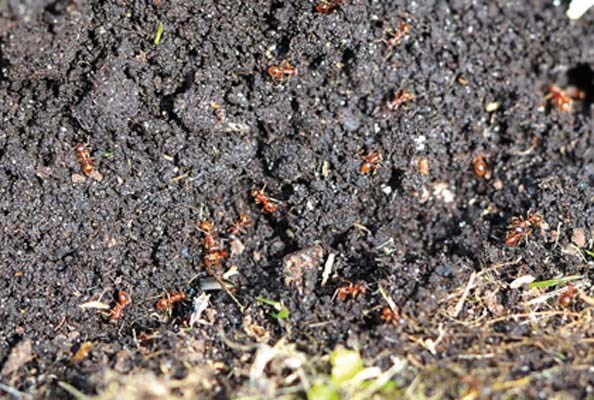Gardeners with plots in Burnaby's largest community garden are fighting an invasive European fire ant infestation.
The aggressive ants, which are known to swarm and sting people and pets when disturbed, have been spotted in community garden plots at the Burnaby and Region Allotment Gardens, a 5.9-hectare swath of farmland in South Burnaby.
Garden association president Abdul Majid told the NOW the ants seem to be spreading.
"We're not sure exactly how it started. We noticed the ants last year. Last year is when they were identified as European fire ants," he said. "(This year) they seem to have spread a bit more. They were in isolated plots. ... We found them in more plots this year."
To combat the problem, the garden association got in touch with entomologist Robert Higgins.
"We've come up with a local remedy, which is using sugar water mixed with Borax," Majid said. "We make a solution out of that and dip cotton balls into it, ... and put it near the nest site. The ants get attracted to the sugar. They take it back and feed the queen, which kills her. That's one way of making sure they don't propagate and spread."
Majid isn't sure how many plots are affected, but the association has been giving away the ant bait to anyone who needs it. More than 400 people use the community garden, he added.
Majid has not noted any improvements yet.
"That takes a long time, and you have to be persistent," he said. "There are just too many of them."
Majid said gardeners, including himself, have been stung by the fire ants.
"You do end up getting bit if you're going to be working in the soil. They are pretty aggressive," he said. "It's a painful bite in a sense. It feels like you've been pricked by something really hard, like a hot pin, and then it swells up like a welt, but different people react differently."
Higgins, a Thompson Rivers University entomologist who specializes in ants, said the invasive European fire ant acts differently here in B.C.
"It doesn't behave this way at all in Europe. While it does have a tendency to sting there, it's nowhere near as aggressive, and it doesn't appear to form colonies nearly as dense as it does in North America," he said. "It seems to be a characteristic of invasive ants. - Ones that become invasive appear to undergo a few shifts in behaviour that seem to make them more likely to establish when they are brought into a new location."
Higgins said the ants tend to behave aggressively if there are more than a couple of nests close together.
"Once they begin to establish a fairly high nest density, they become fairly dangerous. - They swarm out of the nest quite rapidly and swarm whatever they perceive is the (threat) - and sting," he said. "If you had children or pets, you wouldn't be able to leave them unsupervised. It's a problem that way. You can't use the property recreationally."
Higgins said there have been two cases that he knows of, one in Burnaby and one in Vancouver, of people who had to go to emergency because of unusual swelling following stings by European fire ants.
The European fire ant is about four millimetres long, skinny and red, but its aggressive behaviour sets it apart.
"(If it's) swarming and stinging, it probably is the European fire ant," Higgins said. "But to confirm the identity, we would have to get it under a microscope."
Higgins said the ants have the potential to spread east to Hope and north to Prince Rupert along the coast, since they prefer damp environments.
Next week, Higgins is meeting with environmental managers from Burnaby and other municipalities to come up with a plan to deal with the invasive ants. The Invasive Species Council of B.C. is organizing a meeting, which will be held at Burnaby's Shadbolt Centre on Tuesday, June 26.
"We hope during that meeting we will confirm a strategy to confront this ant and at the very least stop it from spreading to areas that are not infested," he said.
Higgins said people should be very cautious about new landscaping or bedding plants they bring in.
"If there are ants in the soil, they should be submerged in water for one hour," he said. "That's probably where they are coming in originally, is through the landscaping industry."
Higgins said one of the fortunate things about the ant is it doesn't like crossing roads, so they may be found in one city block but not the neighbouring one.
"Community gardens are a worry because gardeners have a tendency to share plants and move soil, so there's a risk of introducing it to new locations. One of the items that's going to come out of next week is the need for awareness in the community gardens," Higgins said.
As for how the species got there in the first place, Majid said there are several possibilities.
"With invasive species, they usually come when people import plants," he said. "We have more than 400 members. It could have come in with soil or an infected piece of compost they bring. It could have been anything."



